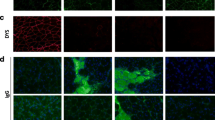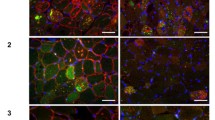Abstract
Muscular dystrophies (MDs) such as Duchenne muscular dystrophy (DMD), sarcoglycanopathy (Sgpy) and dysferlinopathy (Dysfy) are recessive genetic neuromuscular diseases that display muscle degeneration. Although these MDs have comparable endpoints of muscle pathology, the onset, severity and the course of these diseases are diverse. Different mechanisms downstream of genetic mutations might underlie the disparity in these pathologies. We surmised that oxidative damage and altered antioxidant function might contribute to these differences. The oxidant and antioxidant markers in the muscle biopsies from patients with DMD (n = 15), Sgpy (n = 15) and Dysfy (n = 15) were compared to controls (n = 10). Protein oxidation and lipid peroxidation was evident in all MDs and correlated with the severity of pathology, with DMD, the most severe dystrophic condition showing maximum damage, followed by Sgpy and Dysfy. Oxidative damage in DMD and Sgpy was attributed to the depletion of glutathione (GSH) and lowered antioxidant activities while loss of GSH peroxidase and GSH-S-transferase activities was observed in Dysfy. Lower GSH level in DMD was due to lowered activity of gamma-glutamyl cysteine ligase, the rate limiting enzyme in GSH synthesis. Similar analysis in cardiotoxin (CTX) mouse model of MD showed that the dystrophic muscle pathology correlated with GSH depletion and lipid peroxidation. Depletion of GSH prior to CTX exposure in C2C12 myoblasts exacerbated oxidative damage and myotoxicity. We deduce that the pro and anti-oxidant mechanisms could be correlated to the severity of MD and might influence the dystrophic pathology to a different extent in various MDs. On a therapeutic note, this could help in evolving novel therapies that offer myoprotection in MD.







Similar content being viewed by others
Abbreviations
- NMD:
-
Neuromuscular disease
- MD:
-
Muscular dystrophy
- DMD:
-
Duchenne muscular dystrophy
- Sgpy:
-
Sarcoglycanopathy
- Dysfy:
-
Dysferlinopathy
- GSH:
-
Glutathione
- SOD:
-
Superoxide dismutase
- MDA:
-
Malondialdehyde
- 3-NT:
-
3-Nitrotyrosine
- GCL:
-
Gamma glutamyl cysteine ligase
- GPx:
-
Glutathione peroxidase
- GR:
-
Glutathione reductase
- GST:
-
Glutathione-s-transferase
- CTX:
-
Cardiotoxin
- ROS:
-
Reactive oxygen species
- MTT:
-
3-(4,5-Dimethylthiazol-2-yl)-2,5-diphenyltetrazolium bromide
- DNPH:
-
Dinitrophenyl hydrazine
- PN:
-
Peroxynitrite
References
Dubowitz V, Sewry CA (2007) Muscle biopsy—a practical approach, 3rd edn. Saunders Elsevier, London
Munoz P, Rosemblatt M, Testar X, Palacin M, Zorzano A (1995) Isolation and characterization of distinct domains of sarcolemma and T-tubules from rat skeletal muscle. Biochem J 307(Pt 1):273–280
Rando TA (2001) The dystrophin-glycoprotein complex, cellular signaling, and the regulation of cell survival in the muscular dystrophies. Muscle Nerve 24(12):1575–1594
Emery AEH (1999) Neuromuscular disorders: clinical and molecular genetics. Wiley, England
Burr IM, Asayama K, Fenichel GM (1987) Superoxide dismutases, glutathione peroxidase, and catalase in neuromuscular disease. Muscle Nerve 10(2):150–154. doi:10.1002/mus.880100208
Kar NC, Pearson CM (1979) Catalase, superoxide dismutase, glutathione reductase and thiobarbituric acid-reactive products in normal and dystrophic human muscle. Clin Chim Acta 94(3):277–280
Jongpiputvanich S, Sueblinvong T, Norapucsunton T (2005) Mitochondrial respiratory chain dysfunction in various neuromuscular diseases. J Clin Neurosci 12(4):426–428. doi:10.1016/j.jocn.2004.06.014
Haslbeck KM, Friess U, Schleicher ED, Bierhaus A, Nawroth PP, Kirchner A, Pauli E, Neundorfer B, Heuss D (2005) The RAGE pathway in inflammatory myopathies and limb girdle muscular dystrophy. Acta Neuropathol 110(3):247–254. doi:10.1007/s00401-005-1043-3
Burri BJ, Chan SG, Berry AJ, Yarnell SK (1980) Blood levels of superoxide dismutase and glutathione peroxidase in Duchenne muscular dystrophy. Clin Chim Acta 105(2):249–255
Grosso S, Perrone S, Longini M, Bruno C, Minetti C, Gazzolo D, Balestri P, Buonocore G (2008) Isoprostanes in dystrophinopathy: evidence of increased oxidative stress. Brain Dev 30(6):391–395. doi:10.1016/j.braindev.2007.11.005
Haycock JW, Mac Neil S, Mantle D (1998) Differential protein oxidation in Duchenne and Becker muscular dystrophy. Neuro Report 9(10):2201–2207
Nakae Y, Stoward PJ, Kashiyama T, Shono M, Akagi A, Matsuzaki T, Nonaka I (2004) Early onset of lipofuscin accumulation in dystrophin-deficient skeletal muscles of DMD patients and mdx mice. J Mol Histol 35(5):489–499
Dudley RW, Khairallah M, Mohammed S, Lands L, Des Rosiers C, Petrof BJ (2006) Dynamic responses of the glutathione system to acute oxidative stress in dystrophic mouse (mdx) muscles. Am J Physiol Regul Integr Comp Physiol 291(3):704–710. doi:10.1152/ajpregu.00031.2006
Ragusa RJ, Chow CK, Porter JD (1997) Oxidative stress as a potential pathogenic mechanism in an animal model of Duchenne muscular dystrophy. Neuromuscul Disord 7(6–7):379–386
Dudley RW, Danialou G, Govindaraju K, Lands L, Eidelman DE, Petrof BJ (2006) Sarcolemmal damage in dystrophin deficiency is modulated by synergistic interactions between mechanical and oxidative/nitrosative stresses. Am J Pathol 168(4): 1276–1287; quiz 1404-1275. doi:10.2353/ajpath.2006.050683
Murphy ME, Kehrer JP (1986) Activities of antioxidant enzymes in muscle, liver and lung of chickens with inherited muscular dystrophy. Biochem Biophys Res Commun 134(2):550–556
Salminen A, Kihlstrom M (1989) Increased susceptibility to lipid peroxidation in skeletal muscles of dystrophic hamsters. Experientia 45(8):747–749
Bradford MM (1976) A rapid and sensitive method for the quantitation of microgram quantities of protein utilizing the principle of protein-dye binding. Anal Biochem 72:248–254
Renjini R, Gayathri N, Nalini A, Srinivas Bharath MM (2011) Analysis of Calpain 3 protein in muscle biopsies of different muscular dystrophies from India. Indian J Med Res (in press)
Hsu DK, Guo Y, Alberts GF, Copeland NG, Gilbert DJ, Jenkins NA, Peifley KA, Winkles JA (1996) Identification of a murine TEF-1-related gene expressed after mitogenic stimulation of quiescent fibroblasts and during myogenic differentiation. J Biol Chem 271(23):13786–13795
Ardite E, Barbera JA, Roca J, Fernandez-Checa JC (2004) Glutathione depletion impairs myogenic differentiation of murine skeletal muscle C2C12 cells through sustained NF-kappaB activation. Am J Pathol 165(3):719–728
Vali S, Mythri RB, Jagatha B, Padiadpu J, Ramanujan KS, Andersen JK, Gorin F, Bharath MM (2007) Integrating glutathione metabolism and mitochondrial dysfunction with implications for Parkinson’s disease: a dynamic model. Neuroscience 149(4):917–930. doi:10.1016/j.neuroscience.2007.08.028
Ohashi T, Kakimoto K, Sokawa Y, Taketani S (2002) Semi-quantitative estimation of heme/hemoprotein with dichlorodihydrofluorescin diacetate. Anal Biochem 308(2):392–395
Harish G, Venkateshappa C, Mythri RB, Dubey SK, Mishra K, Singh N, Vali S, Bharath MM (2010) Bioconjugates of curcumin display improved protection against glutathione depletion mediated oxidative stress in a dopaminergic neuronal cell line: implications for Parkinson’s disease. Bioorg Med Chem 18(7):2631–2638. doi:10.1016/j.bmc.2010.02.029
Kherif S, Lafuma C, Dehaupas M, Lachkar S, Fournier JG, Verdiere-Sahuque M, Fardeau M, Alameddine HS (1999) Expression of matrix metalloproteinases 2 and 9 in regenerating skeletal muscle: a study in experimentally injured and mdx muscles. Dev Biol 205(1):158–170. doi:10.1006/dbio.1998.9107
Ohkawa H, Ohishi N, Yagi K (1979) Assay for lipid peroxides in animal tissues by thiobarbituric acid reaction. Anal Biochem 95(2):351–358
Mythri RB, Venkateshappa C, Harish G, Mahadevan A, Muthane UB, Yasha TC, Srinivas Bharath MM, Shankar SK (2011) Evaluation of markers of oxidative stress, antioxidant function and astrocytic proliferation in the striatum and frontal cortex of Parkinson’s disease brains. Neurochem Res 36(8):1452–1463. doi:10.1007/s11064-011-0471-9
Levine RL, Garland D, Oliver CN, Amici A, Climent I, Lenz AG, Ahn BW, Shaltiel S, Stadtman ER (1990) Determination of carbonyl content in oxidatively modified proteins. Methods Enzymol 186:464–478
Mythri RB, Jagatha B, Pradhan N, Andersen J, Bharath MM (2007) Mitochondrial complex I inhibition in Parkinson’s disease: how can curcumin protect mitochondria? Antioxid Redox Signal 9(3):399–408. doi:10.1089/ars.2007.9.ft-25
Sambrook J, Russell DW (2001) Molecular cloning, a laboratory manual, 3rd ed edn. Cold spring Harbor Laboratory Press, New York
Bagnyukova TV, Storey KB, Lushchak VI (2003) Induction of oxidative stress in Rana ridibunda during recovery from winter hibernation. J Therm Biol 28(1):21–28. doi:10.1016/s0306-4565(02)00031-1
Aebi H (1984) Catalase in vitro. Methods Enzymol 105:121–126
Flohe L, Gunzler WA (1984) Assays of glutathione peroxidase. Methods Enzymol 105:114–121
Carlberg I, Mannervik B (1985) Glutathione reductase. Methods Enzymol 113:484–490
Guthenberg C, Alin P, Mannervik B (1985) Glutathione transferase from rat testis. Methods Enzymol 113:507–510
Seelig GF, Meister A (1985) Glutathione biosynthesis; gamma-glutamylcysteine synthetase from rat kidney. Methods Enzymol 113:379–390
Hill KE, McCollum GW, Burk RF (1997) Determination of thioredoxin reductase activity in rat liver supernatant. Anal Biochem 253(1):123–125. doi:10.1006/abio.1997.2373
Brancaccio P, Lippi G, Maffulli N (2010) Biochemical markers of muscular damage. Clin Chem Lab Med 48(6):757–767. doi:10.1515/cclm.2010.179
Degl’Innocenti D, Rosati F, Iantomasi T, Vincenzini MT, Ramponi G (1999) GSH system in relation to redox state in dystrophic skin fibroblasts. Biochimie 81(11):1025–1029
Khouzami L, Bourin MC, Christov C, Damy T, Escoubet B, Caramelle P, Perier M, Wahbi K, Meune C, Pavoine C, Pecker F (2010) Delayed cardiomyopathy in dystrophin deficient mdx mice relies on intrinsic glutathione resource. Am J Pathol 177(3):1356–1364. doi:10.2353/ajpath.2010.090479
Spassov A, Gredes T, Gedrange T, Pavlovic D, Lupp A, Kunert-Keil C (2010) Increased oxidative stress in dystrophin deficient (mdx) mice masticatory muscles. Exp Toxicol Pathol. doi:10.1016/j.etp.2010.04.006
Jackson MJ (2008) Redox regulation of skeletal muscle. IUBMB Life 60(8):497–501. doi:10.1002/iub.72
Dorchies OM, Wagner S, Buetler TM, Ruegg UT (2009) Protection of dystrophic muscle cells with polyphenols from green tea correlates with improved glutathione balance and increased expression of 67LR, a receptor for (-)-epigallocatechin gallate. Biofactors 35(3):279–294. doi:10.1002/biof.34
Jackson MJ, Brooke MH, Kaiser K, Edwards RH (1991) Glutathione depletion during experimental damage to rat skeletal muscle and its relevance to Duchenne muscular dystrophy. Clin Sci (Lond) 80(6):559–564
Lesgards JF, Gauthier C, Iovanna J, Vidal N, Dolla A, Stocker P (2011) Effect of reactive oxygen and carbonyl species on crucial cellular antioxidant enzymes. Chem Biol Interact 190(1):28–34. doi:10.1016/j.cbi.2010.12.028
Kramerova I, Kudryashova E, Wu B, Germain S, Vandenborne K, Romain N, Haller RG, Verity MA, Spencer MJ (2009) Mitochondrial abnormalities, energy deficit and oxidative stress are features of calpain 3 deficiency in skeletal muscle. Hum Mol Genet 18(17):3194–3205. doi:10.1093/hmg/ddp257
Dioszeghy P, Imre S, Mechler F (1989) Lipid peroxidation and superoxide dismutase activity in muscle and erythrocytes in adult muscular dystrophies and neurogenic atrophies. Eur Arch Psychiatry Neurol Sci 238(3):175–177
Potgieter M, Pretorius E, Van der Merwe CF, Beukes M, Vieira WA, Auer RE, Auer M, Meyer S (2011) Histological assessment of SJL/J mice treated with the antioxidants coenzyme Q10 and resveratrol. Micron 42(3):275–282. doi:10.1016/j.micron.2010.10.001
Bharath S, Hsu M, Kaur D, Rajagopalan S, Andersen JK (2002) Glutathione, iron and Parkinson’s disease. Biochem Pharmacol 64(5–6):1037–1048
Tidball JG, Wehling-Henricks M (2007) The role of free radicals in the pathophysiology of muscular dystrophy. J Appl Physiol 102(4):1677–1686
Vidal B, Serrano AL, Tjwa M, Suelves M, Ardite E, De Mori R, Baeza-Raja B, Martinez de Lagran M, Lafuste P, Ruiz-Bonilla V, Jardi M, Gherardi R, Christov C, Dierssen M, Carmeliet P, Degen JL, Dewerchin M, Munoz-Canoves P (2008) Fibrinogen drives dystrophic muscle fibrosis via a TGFbeta/alternative macrophage activation pathway. Genes Dev 22(13):1747–1752. doi:10.1101/gad.465908
Yuasa K, Hagiwara Y, Ando M, Nakamura A, Takeda S, Hijikata T (2008) MicroRNA-206 is highly expressed in newly formed muscle fibers: implications regarding potential for muscle regeneration and maturation in muscular dystrophy. Cell Struct Funct 33(2):163–169
Acknowledgments
This work was financially supported by the Department of Science and Technology, India. RR is a senior research fellow of the Council for Scientific and Industrial Research, India. The authors thank all the patients and their families for the muscle biopsies. RR and MMSB conceived the experiments. RR and NG carried out the experiments. AN carried out the clinical analysis. MMSB, RR and NG analyzed the data. RR and MMSB wrote the paper.
Author information
Authors and Affiliations
Corresponding author
Electronic supplementary material
Below is the link to the electronic supplementary material.
Rights and permissions
About this article
Cite this article
Renjini, R., Gayathri, N., Nalini, A. et al. Oxidative Damage in Muscular Dystrophy Correlates with the Severity of the Pathology: Role of Glutathione Metabolism. Neurochem Res 37, 885–898 (2012). https://doi.org/10.1007/s11064-011-0683-z
Received:
Accepted:
Published:
Issue Date:
DOI: https://doi.org/10.1007/s11064-011-0683-z




